
All categories
Featured selections
Trade Assurance
Buyer Central
Help Center
Get the app
Become a supplier

(1392 products available)
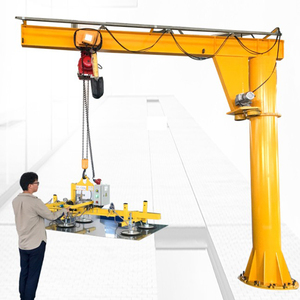
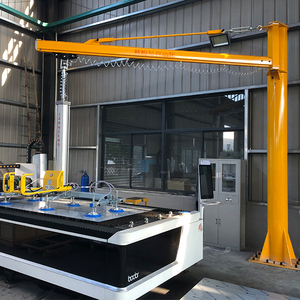

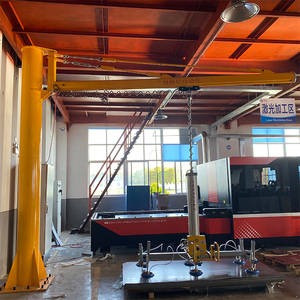
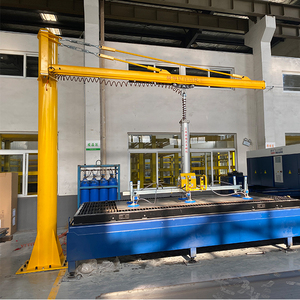
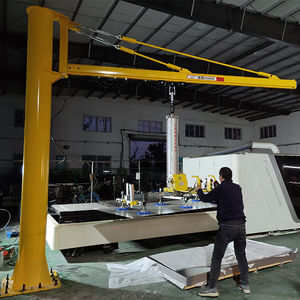












































An automated overhead crane is a large machine that lifts and transports heavy materials in a facility, usually from two points of support fixed on a vertical wall or column. The overhead crane moves in the form of a bridge across a workstation. There are different types of overhead cranes that can be used in large construction works, warehouses, and factories to assemble lines, hot metal, machine parts, and other heavy components. One key characteristic of an overhead crane is how it is powered and operated. This defines its automation level.
Automated Pendants and Push Buttons Cranes:
They are often suspended from the overhead crane or mounted on the crane's side. The operators move safely away from the load and press the buttons for the crane to execute orders. This improves the safety of crane operators in hazardous environments.
Remote Controlled Cranes:
Automated remote overhead cranes allow the operator to control the movement of objects loaded from a distance using a remote transmitter. One advantage of remote-controlled overhead cranes is that they permit the operator to navigate the load from any desired position and location within the range of the remote control signal.
Automated Overhead Cranes with Human Presence:
In this type, overhead cranes are programmed to follow predetermined instructions without human intervention. The human operators, however, remain present for monitoring purposes.
Fully Automated Overhead Cranes:
This type of automated overhead crane is capable of executing tasks without any human intervention. They are programmed and equipped with advanced sensors and safety features for navigation, load detection, and path planning.
Hybrid Automated Overhead Cranes:
These allow humans to monitor and control the movements of the overhead crane while also performing some automated tasks.
Capacity
The capacity of the automated overhead crane refers to the maximum weight it can safely lift and carry. Overhead cranes with varying capacities are available to accommodate different weight requirements, ranging from smaller cranes intended for lighter loads to larger industrial cranes engineered for handling hefty and bulky materials.
Span
The span of an automated overhead crane refers to the distance between its runways. The runways are the horizontal beams that support the crane and allow it to traverse across the area. The quantity and dimensions of the span must suit the particular application and operational setting, as they define the width of the area that the crane can cover.
Lift
The lift of an automated overhead crane pertains to the vertical distance it can raise loads. This dimension is crucial for applications requiring lifting materials to particular heights or levels. The lift is dependent on the design of the crane and the specification of its components, such as the hoist and trolley.
Controls
The controls of an automated overhead crane refer to the methods and systems utilized for managing and maneuvering the crane. These controls permit the operator to position and move the load precisely. Various types of control systems are available for overhead cranes, ranging from manual controls to automated and advanced features like remote controls, pendant controls, and more.
Power Source
An automated overhead crane's power source provides electricity for operating and controlling the crane. The power source may take the form of an electric motor, which powers the crane's movements, lifts the load, and supplies energy to the control system.
Regular inspections
It is crucial to schedule routine inspections by expert technicians. They will examine the crane's structure, hoisting mechanism, control system, etc. Following the provided guidelines and conducting regular inspections is vital to ensuring early detection of potential issues and maintaining the crane's safety and functionality.
Lubrication
Automated overhead cranes have numerous moving parts needing regular lubrication to ensure smooth operation and reduce wear. It's important to promptly address any joint or part that requires lubrication, as this helps maintain the crane's performance and prolong its lifespan.
Testing
Conducting load tests and functional tests is also necessary during routine maintenance. These tests help ensure the crane operates correctly and can safely handle its designated loads. Following the prescribed maintenance schedule and protocols is essential for the crane's reliability and the safety of those using it.
The following industries benefit from the uses of automated overhead cranes:
Manufacturing industries:
Assembly lines and factories use overhead automated cranes to move products along production lines frequently. It does this with little operator intervention. Overhead cranes with automation lift, position, and transfer components on the assembly line to boost output and efficiency.
Distribution centers:
Overhead automated cranes help stack, pick, and move orders of packages in many storage facilities. The cranes travel along beams at the facility's ceiling and retrieve items that are well-placed on high shelves. With this, human effort is reduced, order-picking speed is improved, and the distribution center's efficiency is increased.
Automotive industry:
Automated overhead cranes play a vital role in the automotive industry as an essential tool. They assist in efficiently and precisely handling heavy vehicle parts during production, assembly, and maintenance operations. These cranes' automated features enable smooth and controlled movement, reducing assembly time, boosting productivity, and ensuring worker safety by minimizing manual lifting and lowering.
Aerospace industry:
Overhead cranes with automation are commonly used in the construction and maintenance of aircraft. Large crane systems easily and safely bear the weights of the heavy metal, fabric, and other components of the aircraft. The automated overhead crane does its task of simply lifting and moving components where they should go with a margin of sufficient safety and precision.
Shipyard:
Automated overhead cranes are used in shipyards to build and repair ships, as well as in maritime and offshore industries. The heavy and big maritime equipment and parts are effortlessly transported by the overhead crane. This is because the heavy and bulky ship parts and equipment require precise transportation and positioning.
It is important to consider a variety of factors when selecting an automated overhead crane for business needs.
Assess operational needs
The first step is to identify the specific requirements and expectations of the situation. Determine the maximum weight capacity and dimensions of the materials that the crane will handle. Additionally, examine the layout of the facility, including the height and width of the space, to see if an automated overhead crane system will fit. Also, consider how frequently and quickly the crane needs to move materials and whether it needs to be linked with other systems, like automated guided vehicles or inventory management software.
Weight capacity and heading size
Choose a crane with an appropriate weight capacity and dimensions for the materials to be handled, which is crucial to preventing any potential problems. In addition, determine the maximum height at which the crane needs to operate and ensure that the selected one can reach that height.
Control options
Think about the level of sophistication needed for the automated overhead crane's controls. Simple remote controls may suffice in some cases, while more complex needs for integration and data tracking may require choosing a crane with advanced programmable controls and different options for communication.
Safety features
Pay close attention to the automated overhead crane's built-in safety characteristics, like collision detection and emergency stop systems. These elements are essential for ensuring safe operations and protecting both workers and important equipment.
Conduct vendor comparison
When considering different automated overhead crane system providers, it is important to look beyond product specifications and performance data. Also, consider the full range of support services, including installation assistance, training programs for staff, preventive maintenance plans, and response times for technical help. It is necessary to evaluate comprehensive customer care from each supplier to determine which one can best meet operational needs throughout the equipment's lifecycle.
Q1: How safe is an automated overhead crane?
A1: Safety is paramount in crane design. Automated cranes are equipped with overload sensors, emergency stop buttons, anti-collision systems, and soft start/stop functions to protect both the machine and the environment. Additionally, they can be designed to comply with specific international standards for safety.
Q2: How long does it take to install an automated overhead crane?
A2: Small, pre-assembled automated cranes may only take a few days to install. However, large-capacity cranes with complex automation can take several weeks or even months to install and commission properly.
Q3: What is the load capacity range for automated overhead cranes?
A3: Automated cranes with different configurations have capacities ranging from a few tons to several hundred tons. The specific load capacity depends on factors like the design, the materials used, and the structure of the crane.
Q4: Can an automated overhead crane be used outdoors?
A4: Overhead cranes are primarily designed for indoor use. Their automation components are protected from the elements. However, they can be used outdoors, provided they are properly weatherized.